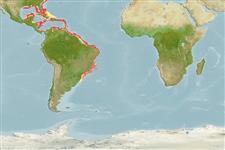Environment: milieu / climate zone / depth range / distribution range
Ecologia
marino demersale; distribuzione batimetrica 60 - 300 m (Ref. 7251). Tropical; 35°N - 33°S, 100°W - 33°W
Western Atlantic: South Carolina, USA and northern Gulf of Mexico to the Caribbean Sea; probably more widespread. Reported from the northern coast of South America (Ref. 5217).
Size / Peso / Age
Maturity: Lm ? range ? - ? cm
Max length : 50.0 cm TL maschio/sesso non determinato; (Ref. 5217); common length : 35.0 cm TL maschio/sesso non determinato; (Ref. 5217)
Spine dorsali (totale) : 10; Raggi dorsali molli (totale) : 14; Spine anali: 3; Raggi anali molli: 8. Pelvic fin long, its tip extending posteriorly beyond origin of anal fin; caudal fin deeply emarginate, upper lobe projecting posteriorly; body silver with a pink cast dorsally, silvery-white ventrally; a yellow line extending from snout through lower edge of eye to posterior margin of opercle; pectoral fin pink, other fins yellow (Ref. 13608).
Occurs over hard bottoms.
Life cycle and mating behavior
Maturities | Riproduzione | Spawnings | Egg(s) | Fecundities | Larve
Robins, C.R. and G.C. Ray, 1986. A field guide to Atlantic coast fishes of North America. Houghton Mifflin Company, Boston, U.S.A. 354 p. (Ref. 7251)
IUCN Red List Status (Ref. 130435)
Threat to humans
Harmless
Human uses
Pesca: commerciale
Strumenti
Special reports
Download XML
Fonti Internet
Estimates based on models
Preferred temperature (Ref.
123201): 16.9 - 25.2, mean 20 °C (based on 103 cells).
Phylogenetic diversity index (Ref.
82804): PD
50 = 0.6250 [Uniqueness, from 0.5 = low to 2.0 = high].
Trophic level (Ref.
69278): 3.7 ±0.5 se; based on size and trophs of closest relatives
Resilienza (Ref.
120179): Medio, tempo minimo di raddoppiamento della popolazione 1.4 - 4.4 anni (Preliminary K or Fecundity.).
Fishing Vulnerability (Ref.
59153): Moderate vulnerability (40 of 100).
Nutrients (Ref.
124155): Calcium = 101 [42, 181] mg/100g; Iron = 0.896 [0.477, 1.637] mg/100g; Protein = 17.8 [16.0, 19.5] %; Omega3 = 0.28 [0.17, 0.48] g/100g; Selenium = 73 [40, 141] μg/100g; VitaminA = 23.8 [8.3, 78.2] μg/100g; Zinc = 0.956 [0.678, 1.400] mg/100g (wet weight);
